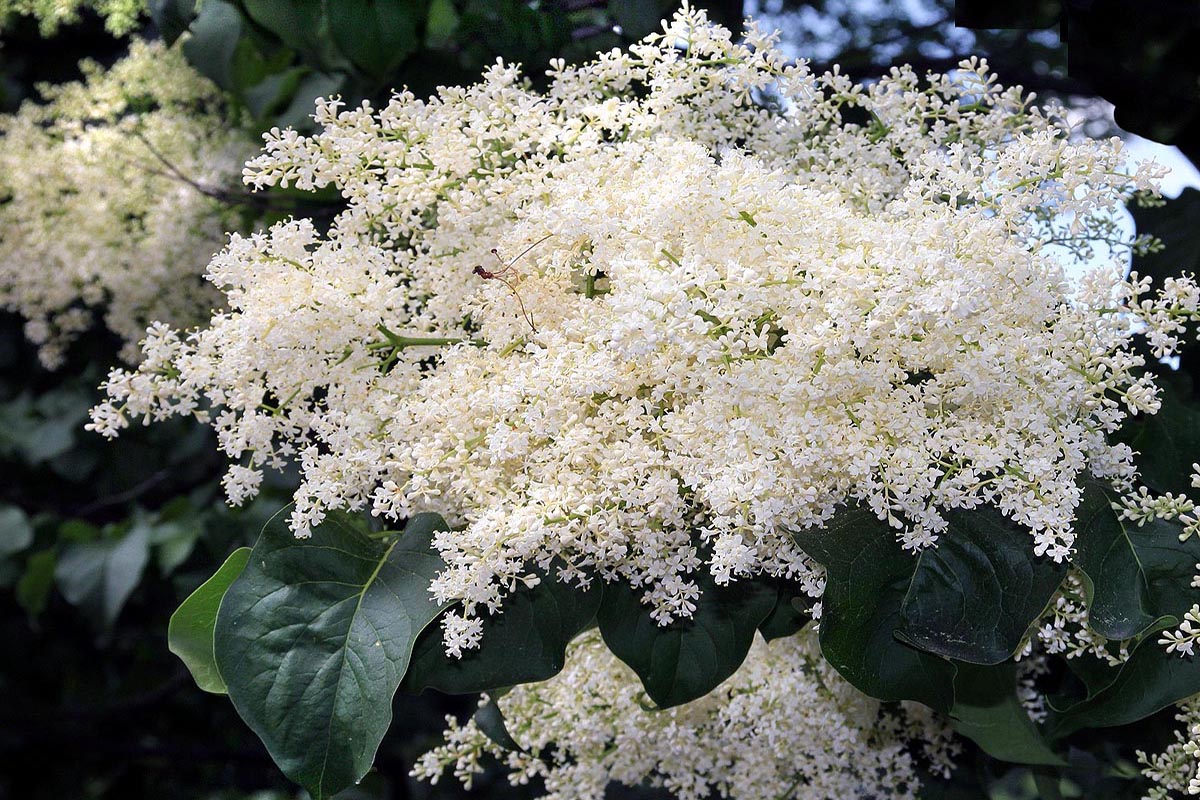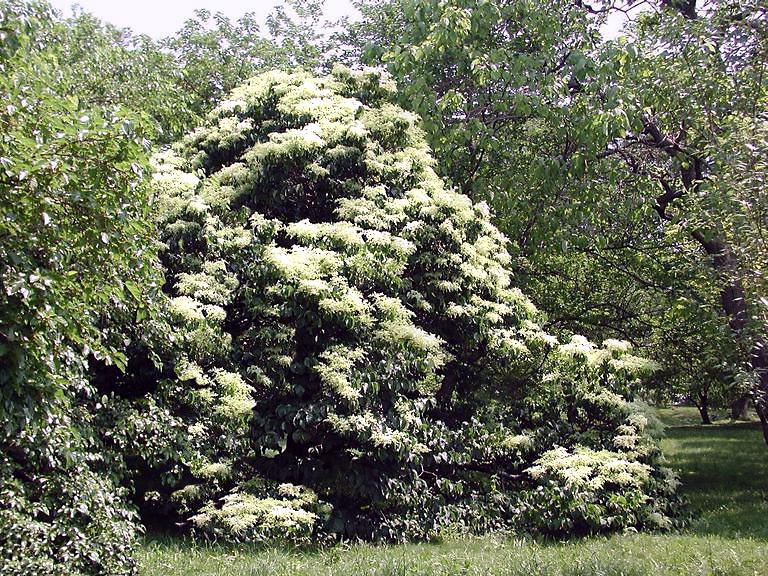The only lilac that forms a tree that can grow to about 40 feet (12.5m) in height. It produces large panicles of bright white flowers at the end of each branch that festoon the tree in late spring to early summer. This makes it a perfect 'gap' flower between spring and summer flowers and thus a magnate for butterflies, humming birds, native bees and some of our most endangered and impressive moths. Tough, hardy to zone 3 likes cooler weather so does not really grow below zone 7. Not too fussy about soil type provided its well drained and is fairly drought tolerant once established so makes a pretty good street tree. That same property also makes it perfect alongside decks, patios and walkways as its no aggressive root system does not disturb surfaces especially if its watered when little rain falls. Flowers are extremely fragrant and its also pretty resistant to powdery mildew which can plague other lilacs and make them unattractive. Its also deer and moose resistant so great for rural areas or where there are lots of deer. Great specimen tree that takes little maintenance once established. Seeds do need moist stratification before they will germinate but its worth the effort for such a lovely versatile tree.
The leaves are anywhere from 3-6 inches (7.6-15cm) long about half as wide, mostly ovate with tapering tip. They are slightly fuzzy on the underside, dark green with a lighter green central vein and thinner light sub-veins, all turning pale yellow to greenish brown in autumn. The are arranged in opposite pairs along the hollow stems and have a drooping habit.
In early summer the flowers bloom from large panicles up to 12 inches (31cm) long that are borne at the ends of the branches. Each one consists of a central stem with opposite branching stems that can branch again and finally bear clusters of small white flowers. Each bloom consists of a tubular base with four ovate petals surrounding two long stamens that protrude out far beyond the petals and a smaller yellow stigma in the center. Flowers bloom for about 1-2 weeks with new small blooms opening throughout. They are very fragrant but do not have the same aroma as bush lilacs, and it often considered to be more like the aromatic privet blooms than lilacs. Some people adore it others find it less appealing.
Flowers are followed by long thin fruit capsules about 3/4 inch (15-20mm) long that are first green ripening to brown and when mature split open to form an attractive V shaped 'mini flower' that releases 1-2 long flat brown seeds. Fruits and their panicles can remain on the tree throughout the winter offering interest to the tree.
The glossy reddish brown bark is studded with numerous horizontal lenticels making it fairly interesting especially in a winter setting. As the tree ages bark develops more scaly grayish plates.
Soak seeds in water for 24 hours then place in damp compost mix or plant in small cell trays or egg boxes wrap in plastic to keep moisture in. Place seeds in the refrigerator or a cold garage or shed for about another 70 - 90 days before bringing out to germinate with all your other seed trays (if you have any of course). Please refer to our Stratification instructions for more details and choose which method you prefer.
Some sources state you need to provide warm stratification for 60 days before it goes to cold. We have not found this necessary for reasonable germination. We usually achieve about 65% germination using the cold only stratification. Its possible that more would be achieved using the other method but for most gardeners (and us) its a more long fiddly time consuming process and we are content with the results we have. So its your choice. If you have more seeds that you need you may want to try it. Its up to you.
Some research has suggested that seeds will germinated immediately if they are plucked from the trees before the capsules even open and planted immediately. This method is not particularly practical for any other than professional growers who have trees on hand and can monitor for the exact time to remove the seeds from the tree, force open the unripe capsules and remove the seeds (not an easy task). The rest of us have much better results mimicking the process that the tree intended for its seeds which is moist stratification.
When sowing seeds use good sterile potting mix and cover seeds lightly with about 1/4 inch (5mm) of compost. Monitor seeds for any mold than can grow if seeds are too moist or mix is not sterile. Even after this method is used seeds can be slow to germinate often taking anywhere from 20-60 days to sprout so don't give up on seeds too early.
Needs full sun for best results, it can take some light to partial shade but it will not produce as many flowers or have such a dense crown.
Soil Type. Tolerates most soil types well but they need to be well draining. Does not do well in wet and waterlogged soils. Will do better with some organic material dug into the soil before planting and regularly yearly mulching and ensuring good drainage.
Water. While it likes to have regular watering to produce the best tree, its tolerance for compacted soils ensures that it is fairly drought tolerant, although added water during long droughts would be highly beneficial or tree will begin to fail
Tree lilac does not have and aggressive root system which means it can be used around patios, decks, walkways driveways and underground septic lines. It also makes it an attractive tree street use and is often used by urban planners. Planted hear a deck or patio is can provide shade as well as perfume from the magnificent flowers that attract butterflies and humming birds.
When growing your tree from seed you will need to do some initial strong pruning. Tree lilacs will form single stem trees but often their natural inclination is to form a shrub with many branches. To create the tree form the others will need to be pruned off.
Study your tree and decide which branch you want to be the central trunk of the tree, then carefully remove all the others. Make sure that the day you choose to do this is in a dry period with no rain for a few days before and not forecast for rain for at least two days. this keeps the moisture down and reduces the likelihood of bacteria or fungi getting into any pruning you do.
Choose an upright stem as straight as possible for your central trunk, then remove any lower branches so the trunk is visible. Keep the lower branches pruned up. Once the main form of the tree has been achieved some later pruning to ensure that it grows in the shape that you want may be needed. Plus keep an eye open for new shoots arising from the ground to challenge your chosen tree trunk.
Start pruning your tree as soon as it has established itself in the desired location. the sooner you remove small branches from the tree the less stress the tree will undertake. If you leave it until the tree is larger then you need to prune in stages if you remove lots of large branches at once it may shock the tree too much and kill it.
As the tree grows older less pruning will be needed.
As a shrub.
If you prefer you can allow your tree lilac to form a more shrub like. In this case much less pruning is required. It is always suggested that some pruning be done to ensure that there are few cross branches and allow good airflow through the shrub. This ensures that its is far less prone to disease and produces more flower clusters.
As a hedge, or fence.
If planted in a row these 'trees' can be pruned into a great hedge. Plant in a row about 6 feet (1.8m) apart and then prune to the desired height and width as the plants grow.
In all cases. remove any branches that cross each other very closely and any that rub against each other as these will remove the bark and allow disease to enter the plant.
However deer and Moose don't eat it! This makes it an excellent choice for rural gardens and areas with lots of deer.
Syringa is part of the olive family. These particular trees are native to northern Japan and are found growing on cliff sides.







